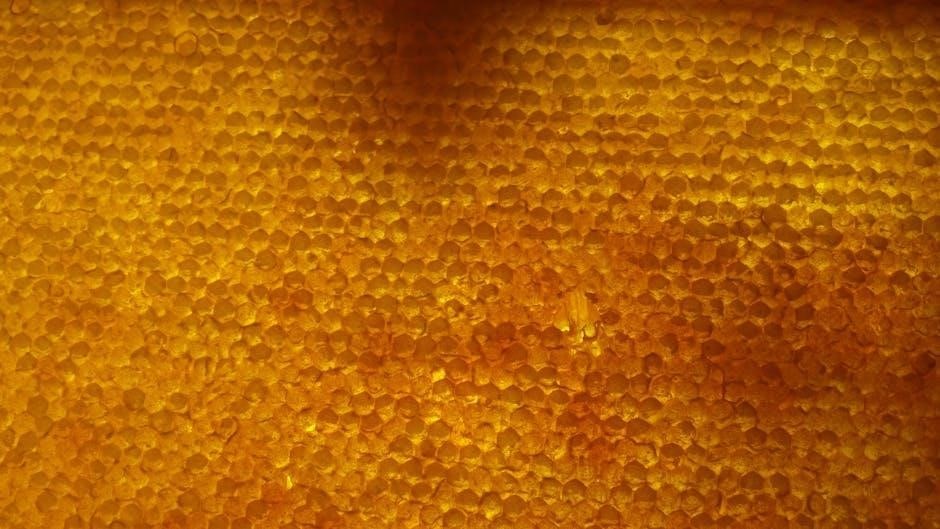Honey production is a fascinating journey from nectar collection to harvesting‚ involving bees’ hard work and precise processes to create this natural sweetener‚ essential for both nutrition and industry.

The Honey Production Process

Honey production involves bees collecting nectar‚ transforming it with enzymes‚ reducing water content‚ and storing it in honeycombs capped with wax‚ creating a natural sweetener.
Nectar Collection by Bees
Bees begin honey production by collecting nectar‚ a sweet‚ energy-rich liquid from flowering plants. Forager bees visit flowers‚ using their long tongues to extract nectar‚ which they store in their honey stomach. They return to the hive and regurgitate the nectar‚ sharing it with house bees. This process starts the transformation of nectar into honey‚ as enzymes are added to break down complex sugars. The nectar is then regurgitated and evaporated multiple times to reduce water content‚ creating a thicker‚ sweeter consistency. This step is crucial for honey production‚ as it prevents fermentation and ensures the honey’s stability. The bees’ precise communication and teamwork are essential for this initial phase‚ laying the foundation for the entire honey-making process.

Enzyme Addition and Water Content Reduction
After collecting nectar‚ bees add enzymes to break down complex sugars into simpler ones‚ enhancing the nectar’s digestibility and stability. This enzymatic process is crucial for honey production‚ as it prevents fermentation and extends shelf life. Bees then regurgitate and evaporate the nectar multiple times‚ reducing its water content from approximately 70% to around 18%. This step is vital‚ as low water content inhibits bacterial growth and ensures honey remains a stable‚ non-perishable food source. The combination of enzyme addition and water reduction transforms nectar into a viscous‚ sweet liquid with unique properties. This phase is essential for creating high-quality honey‚ showcasing the bees’ remarkable ability to process and preserve nectar naturally.
Honeycomb Formation and Capping
Bees construct honeycombs using wax secreted from their bodies‚ forming hexagonal cells to store honey and pollen. Once the honey is ready‚ bees seal the cells with a layer of beeswax‚ a process called capping. This step is critical for preserving the honey’s quality and preventing contamination. The wax capping ensures the honey remains stable and protected from air exposure. The intricate structure of the honeycomb‚ combined with the capping process‚ showcases the bees’ remarkable engineering skills. This phase is essential for maintaining the honey’s purity and readiness for harvesting. The capped honeycomb is a testament to the bees’ hard work and precision‚ ensuring the honey is perfectly preserved for consumption and storage.

Essential Equipment for Beekeeping
Key tools include hives (Langstroth or top-bar)‚ frames with foundation‚ protective gear‚ and extraction tools. These items are vital for managing bees and producing high-quality honey effectively.
Hives: Langstroth and Top-Bar
Langstroth hives are the most common type‚ consisting of stacked boxes with removable frames that allow for easy honey extraction and hive management. Top-bar hives‚ on the other hand‚ use a single horizontal bar to support the honeycomb‚ offering a more natural approach to beekeeping. Both designs provide bees with a structured environment to produce honey‚ but they cater to different beekeeping styles and preferences. Langstroth hives are ideal for commercial production due to their scalability‚ while top-bar hives are often favored by hobbyists for their simplicity and minimal interference with the bees’ natural behavior. Each hive type requires specific maintenance techniques to ensure optimal honey production and bee health.
Frames and Foundation
Frames are essential components of beehives‚ providing a structure for bees to build their honeycomb. They are typically placed inside the hive boxes‚ supporting the beeswax or plastic foundation. The foundation serves as a guide for bees to construct the comb uniformly; Beeswax foundation is preferred for its natural properties‚ while plastic foundation is more durable and easier to clean. Properly installed frames and foundation ensure efficient honey production and simplify hive management. They also help maintain the health of the colony by preventing overcrowding and promoting organized comb construction. Regular inspection and maintenance of frames and foundation are crucial to ensure optimal hive conditions and high-quality honey production. This setup is vital for both Langstroth and top-bar hives‚ catering to different beekeeping preferences and practices.
Protective Gear for Beekeepers
Protective gear is crucial for beekeepers to safely manage their hives and avoid stings. A beekeeping suit‚ typically made of durable fabric‚ covers the entire body‚ while a veil protects the face and neck from stings. Gloves are worn to prevent stings when handling frames and bees. Smokers are also essential tools‚ as they calm bees by producing smoke‚ reducing aggression. Proper fit and regular maintenance of protective gear ensure effectiveness. These items are vital for both experienced beekeepers and newcomers‚ allowing them to work confidently with their colonies. Protective gear not only safeguards against stings but also helps maintain a positive interaction between the beekeeper and the bees‚ fostering a healthy and productive hive environment. Investing in quality protective equipment is a cornerstone of successful beekeeping practices.

Extraction Tools and Accessories
Extraction tools and accessories are vital for efficiently harvesting honey while preserving the quality of the honeycomb. A honey extractor is the primary tool‚ using centrifugal force to extract honey from frames without damaging the comb. Frames are placed inside the extractor‚ and the honey is spun out into a collection tank. Uncapping tools‚ such as uncapping knives or scrapers‚ are used to remove the wax capping from honeycomb cells before extraction. Filters and sieves are employed to strain the honey‚ removing impurities and debris. Additional accessories like honey buckets‚ taps‚ and bottling equipment ensure the honey is stored and packaged safely. These tools not only streamline the extraction process but also help maintain the integrity and quality of the honey‚ making them indispensable for beekeepers aiming to produce high-grade honey;

Quality Control and Packaging
Quality control ensures honey’s purity and consistency‚ while effective packaging methods preserve its natural properties‚ maintaining its quality and appeal for consumers.
Maintaining Honey Quality
Maintaining honey quality involves ensuring its purity‚ consistency‚ and nutritional integrity. Proper extraction‚ filtration‚ and storage are critical to preserve its natural properties. Raw honey‚ for instance‚ is minimally processed to retain its enzymes and antioxidants. Beekeepers must monitor moisture content to prevent fermentation and spoilage. Temperature control during extraction helps protect delicate nutrients. Additionally‚ storing honey in clean‚ airtight containers away from heat and light prevents contamination and degradation. Regular quality checks ensure the honey meets standards for taste‚ texture‚ and aroma. Proper handling and packaging further safeguard its quality‚ making it suitable for consumption and market distribution. By adhering to these practices‚ beekeepers can deliver high-quality honey that retains its natural benefits and appeals to consumers.
Effective Packaging Methods
Effective packaging is crucial for preserving honey’s quality and appeal. Glass jars and food-grade plastic containers are popular choices due to their airtight sealing‚ which prevents contamination and moisture absorption. Proper labeling with nutritional information‚ production dates‚ and branding enhances consumer trust and marketability. Bottling in small‚ portable sizes caters to retail demands‚ while bulk packaging suits industrial or wholesale needs. Clear labeling‚ including certifications like “raw” or “organic‚” attracts health-conscious buyers. Additionally‚ protective packaging materials‚ such as bubble wrap or cardboard boxes‚ ensure safe transportation and storage. Proper sealing and storage in cool‚ dry places maintain honey’s consistency and flavor. These methods not only extend shelf life but also enhance the product’s presentation and consumer satisfaction‚ making it ready for distribution and retail.

Marketing and Selling Honey
Effective branding‚ distribution channels‚ and competitive pricing are key to successfully marketing honey‚ ensuring it stands out in a crowded market while maintaining quality and consumer trust.
Branding Strategies

Branding is crucial for distinguishing your honey in a competitive market. Develop a unique identity by highlighting your production process‚ quality‚ and sustainability. Use eco-friendly packaging and clear labeling to appeal to environmentally conscious consumers. Storytelling about your beekeeping heritage or unique floral sources can create an emotional connection. Consider certifications like “organic” or “raw” to assure quality. Build trust through transparency about your practices. Engage with customers via social media and local events to promote your brand. Collaborate with local businesses or chefs to feature your honey in products. Consistent branding across all platforms ensures recognition and loyalty. Invest in professional design for logos and packaging to convey professionalism. Effective branding strategies can elevate your honey’s perceived value and attract premium pricing‚ setting it apart from mass-produced alternatives.
Distribution Channels
Effective distribution channels are vital for ensuring your honey reaches consumers efficiently. Start by selling directly to consumers through farmers’ markets‚ roadside stands‚ or online platforms‚ which helps build a loyal customer base. Partner with local grocery stores‚ specialty food shops‚ and co-ops to expand your reach. Wholesaling to larger retailers or distributors can increase scale but may require negotiating pricing and contracts. Consider e-commerce platforms like your own website or marketplaces like Amazon for broader accessibility. Collaborate with restaurants‚ cafes‚ and chefs to feature your honey in their products or menus. Attend food festivals and events to network and promote your brand. Exporting to international markets can further diversify your customer base. Each channel requires strategic planning to ensure timely delivery‚ quality maintenance‚ and profitability. Balancing direct and indirect sales strategies can maximize your honey’s market penetration and customer accessibility.

Benefits and Uses of Honey
Honey is a natural sweetener rich in nutrients‚ used in cooking‚ health remedies‚ and skincare. Its versatility extends to industrial applications‚ making it a valuable resource for various industries and households.
Nutritional Value
Honey is a natural sweetener rich in essential nutrients‚ offering numerous health benefits. It contains carbohydrates‚ vitamins (C‚ B6)‚ minerals (calcium‚ iron‚ zinc‚ potassium‚ magnesium)‚ antioxidants‚ and amino acids. With low fat and fiber content‚ honey serves as an excellent energy source. Its antioxidant properties‚ including flavonoids and phenolic acids‚ contribute to its health-promoting qualities. Honey also contains enzymes that aid digestion and metabolism. While it is calorie-dense (about 64 calories per tablespoon)‚ its unique composition makes it a popular choice for health-conscious individuals. Compared to refined sugars‚ honey has a lower glycemic index‚ making it a better option for blood sugar management. Overall‚ honey’s nutrient-dense profile and versatility make it a valuable addition to a balanced diet‚ supporting both culinary and health applications.
Culinary Applications
Honey is a versatile natural sweetener widely used in culinary applications‚ enhancing flavors in various dishes. It is ideal for baking‚ adding moisture and sweetness to cakes‚ cookies‚ and bread. Honey is also used in dressings‚ marinades‚ and sauces‚ providing a rich‚ caramel-like flavor. Its ability to balance sweet and savory notes makes it a popular choice for glazes and dips. Additionally‚ honey is a key ingredient in beverages‚ such as teas‚ smoothies‚ and cocktails‚ adding a touch of sweetness without refined sugars. It pairs well with fruits‚ cheeses‚ and nuts‚ making it a perfect topping for yogurt‚ oatmeal‚ or ice cream. Honey’s distinct flavors‚ ranging from floral to robust‚ allow chefs and home cooks to experiment with diverse recipes‚ showcasing its culinary versatility and natural charm.
Health Benefits
Honey offers numerous health benefits‚ making it a popular natural remedy. It is rich in vitamins‚ minerals‚ antioxidants‚ and amino acids‚ which help boost immunity and overall well-being. Honey is known for its soothing effects on coughs‚ particularly in children and adults‚ and is often recommended as a natural alternative to cough syrups. Its antibacterial and antifungal properties make it effective in wound healing and skin care. Additionally‚ honey aids in digestion and can help manage symptoms of colds and sore throats. It is also used to support energy levels due to its natural sugars. When consumed raw and unfiltered‚ honey retains its nutritional properties‚ making it a healthier choice for those seeking natural health solutions. Its versatility in health applications has made it a staple in many households and traditional remedies worldwide.
Industrial Uses
Honey’s versatility extends beyond culinary applications‚ making it a valuable resource in various industries. In cosmetics‚ honey is prized for its moisturizing and antibacterial properties‚ commonly used in skincare products and lotions. The food industry leverages honey as a natural sweetener and humectant‚ enhancing flavor and preserving moisture in baked goods‚ beverages‚ and snacks. Pharmaceuticals also utilize honey for its wound-healing properties‚ incorporating it into ointments and dressings. Additionally‚ honey serves as a natural energy source in sports nutrition products. Its sustainability and natural origin make it a sought-after ingredient in eco-friendly manufacturing processes. Beyond these applications‚ honey’s unique characteristics support innovation across multiple sectors‚ solidifying its importance as a versatile and sustainable industrial resource.
Challenges in Honey Production
Honey production faces challenges like environmental factors‚ pests‚ and market competition‚ impacting yield and quality‚ while beekeepers strive to maintain sustainable practices and premium pricing for their products.
Environmental Factors
Environmental factors significantly impact honey production‚ with climate change‚ extreme weather‚ and water scarcity affecting nectar flows and hive health. Rising temperatures and droughts alter flowering patterns‚ reducing the availability of nectar-rich plants. Additionally‚ pollution and pesticides degrade habitats‚ further threatening bee populations. In regions like Basra‚ increased salinity and extreme heat have halved honey production‚ while water crises worsened by dams exacerbate these challenges. Bees struggle to adapt to such conditions‚ leading to lower honey yields and weaker colonies. These environmental stresses highlight the need for sustainable beekeeping practices to mitigate their effects and ensure the long-term viability of honey production. Addressing these issues is crucial for maintaining healthy ecosystems and food supplies.
Pests and Diseases
Pests and diseases pose significant challenges to honey production‚ threatening bee health and hive productivity. Common pests include mites‚ which weaken colonies by feeding on bees‚ and diseases like American foulbrood‚ a bacterial infection that devastates hives. These issues can lead to colony collapse‚ reducing honey yields and requiring costly treatments. Beekeepers must implement rigorous monitoring and maintenance practices to prevent infestations and infections. For instance‚ regular hive inspections and the use of integrated pest management strategies are essential to protect colonies. Additionally‚ maintaining strong‚ healthy colonies through proper nutrition and habitat management helps bees resist pests and diseases. Addressing these challenges is critical to ensuring the sustainability of honey production and the overall health of bee populations. Effective management of pests and diseases is vital for successful beekeeping and high-quality honey output.
Market Competition
The honey market is highly competitive‚ with numerous producers vying for consumer attention. Small-scale beekeepers often struggle to compete with larger operations that can offer lower prices due to economies of scale. However‚ many consumers are willing to pay a premium for high-quality‚ raw‚ or specialty honey‚ creating opportunities for niche producers. Diversification‚ such as offering comb honey or flavored varieties‚ can help beekeepers stand out in a crowded market. Additionally‚ emphasizing sustainable practices and unique branding strategies can attract environmentally conscious consumers. Market competition also drives innovation in packaging‚ marketing‚ and distribution methods. Beekeepers must stay informed about market trends and consumer preferences to remain competitive. By focusing on quality and differentiation‚ smaller producers can carve out a profitable niche in the honey industry. Effective branding and customer engagement are key to thriving in this competitive landscape.
Honey production is a rewarding yet challenging endeavor that highlights the importance of bees in our ecosystem. From nectar collection to packaging‚ the process requires dedication and careful management. Despite challenges like environmental factors and pests‚ the demand for high-quality honey continues to grow. Beekeepers play a vital role in maintaining this natural resource while adapting to market demands. By focusing on sustainable practices and innovation‚ the honey industry can thrive‚ offering both nutritional and economic benefits. Whether for culinary use or industrial applications‚ honey remains a cherished product. As beekeepers strive to optimize their techniques‚ the sweet legacy of honey production endures‚ connecting nature‚ tradition‚ and modern consumers in a timeless journey. The future of honey production lies in balancing tradition with innovation to meet the evolving needs of the market and the environment.

